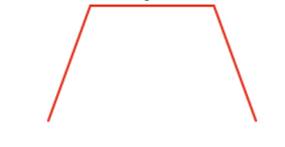
Concept explainers
'Department store dressing rooms often have large mirrors that actually consist of three adjacent mirrors, put together as shown In Flgure 10.54 (as seen looking down from the ceiling). Use the laws of reflection to show how you can stand in such a way as to see the reflection of your back. Make a careful drawing, using an enlarged version of Figure 10.54 , that shows clearly how light reflected off‘ your back can enter your eyes. Your drawing should show where you are standing, the location of your back. and the direction of the gaze of your eyes. (You may wish to experiment with paper folding before you attempt a final drawing. See Practice Exercise 2 .)

Figure 10.54 Department store mirror
Want to see the full answer?
Check out a sample textbook solution
Chapter 10 Solutions
Mathematics for Elementary Teachers with Activities (5th Edition)
Additional Math Textbook Solutions
Discrete Mathematics and Its Applications ( 8th International Edition ) ISBN:9781260091991
Calculus for Business, Economics, Life Sciences, and Social Sciences (14th Edition)
Finite Mathematics with Applications In the Management, Natural, and Social Sciences (12th Edition)
Thinking Mathematically (6th Edition)
Thinking Mathematically (7th Edition)
Discrete Mathematics with Graph Theory (Classic Version) (3rd Edition) (Pearson Modern Classics for Advanced Mathematics Series)
- Compute 1.arrow_forwardConsidering that the consecutive dials on the electric meter rotate in opposite directions, what is the current reading in kilowatt hours of usage? The initial direction is clockwise.arrow_forwardConsidering that the consecutive dials on the natural gas meter rotate in opposite directions, what is the current reading in cubic feet of usage? The initial direction is clockwise.arrow_forward
- Holes are to be drilled in the length of angle iron as shown in Figure 38-1. What is thedistance between two consecutive holes?arrow_forwardUse the information given in Figure 1 to find x, h, s, and r if y=3. (Note: s is the distance from A to D. and y is the distance from D to B .)arrow_forwardThe following problem is based on the Parallelogram Law. In the scaled drawing, each unit corresponds to 50 mph. A small airplane travels due east at 250 mph. The wind is blowing at 50 mph in the direction due north. Using the indicated diagonal and use it to determine the speed of the airplane in miles per hour.arrow_forward
 Elementary Geometry For College Students, 7eGeometryISBN:9781337614085Author:Alexander, Daniel C.; Koeberlein, Geralyn M.Publisher:Cengage,
Elementary Geometry For College Students, 7eGeometryISBN:9781337614085Author:Alexander, Daniel C.; Koeberlein, Geralyn M.Publisher:Cengage, Elementary Geometry for College StudentsGeometryISBN:9781285195698Author:Daniel C. Alexander, Geralyn M. KoeberleinPublisher:Cengage LearningAlgebra & Trigonometry with Analytic GeometryAlgebraISBN:9781133382119Author:SwokowskiPublisher:Cengage
Elementary Geometry for College StudentsGeometryISBN:9781285195698Author:Daniel C. Alexander, Geralyn M. KoeberleinPublisher:Cengage LearningAlgebra & Trigonometry with Analytic GeometryAlgebraISBN:9781133382119Author:SwokowskiPublisher:Cengage Mathematics For Machine TechnologyAdvanced MathISBN:9781337798310Author:Peterson, John.Publisher:Cengage Learning,
Mathematics For Machine TechnologyAdvanced MathISBN:9781337798310Author:Peterson, John.Publisher:Cengage Learning,
 Trigonometry (MindTap Course List)TrigonometryISBN:9781305652224Author:Charles P. McKeague, Mark D. TurnerPublisher:Cengage Learning
Trigonometry (MindTap Course List)TrigonometryISBN:9781305652224Author:Charles P. McKeague, Mark D. TurnerPublisher:Cengage Learning





